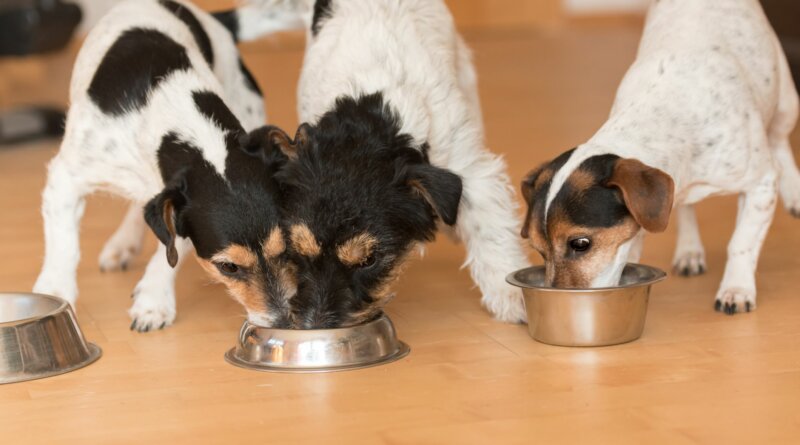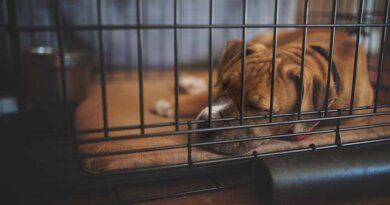Food Aggression – Whole Dog Journal
Your dog’s food aggression can be very scary. Indeed, it can be downright dangerous!
Food aggression is a subset of a larger behavior known as “resource guarding,” in which a dog behaves aggressively to maintain possession of valuable objects including food, toys, chew items, humans, and even favorite places (beds, crates, couches, rooms). Resource guarding, scary as it may be, is a natural, normal canine behavior – one that’s critically important for a wild dog’s survival. If canines in the wild don’t protect their valuable resources, they die.
Of course, your dog doesn’t have to protect his food supply in order to survive – but it’s up to you to manage his environment so he doesn’t feel like he has to! To prevent, reduce, and/or manage your dog’s food aggression, take these actions:
Feed your dog in a low-traffic, stress-free zone and leave her alone while she eats. She shouldn’t feel threatened by others (human or animal) invading her dining space.
Teach your dog that when you approach her food bowl she gets more good stuff. This is accomplished by walking past her as she eats – at a distance that doesn’t cause her stress – and tossing high-value treats (such as fresh, roasted chicken) to her as you pass by. When, after multiple repetitions of this, she grows very happy to see you approaching, you can gradually decrease the distance between you and her bowl as you pass by, until you can toss the treats right into her bowl without causing her any stress. (See “The ‘I Come in Peace’ Resource-Guarding Modification Protocol,” WDJ May 2020.)
Teach your dog a force-free “trade” behavior. Use this cue any time you want something that she has. (See “How to Teach Your Dog to Trade,” February 2017.)
Dog-dog food aggression can worsen over time
Some dog friends communicate perfectly and politely about food they’d both like to have. Ideally, if a dog is approached by another dog while eating, she would send polite canine social signals to leave her alone – such as pausing into a brief “freeze” while eating, giving him a hard stare, and he would back off. The behavior says, “Go away, this is my dinner!” The interloper says, “Oops, sorry!” and moves away. This is a best-case scenario: conflict resolved without escalation.
If the interloper is oblivious to or doesn’t understand the guarder’s signals and continues forward, the guarder may escalate to get her message across and protect her food; she may snarl, snap, and/or lunge. One hopes the interloper gets the message, offers appeasement behaviors, and moves away, and the guarder calms down and goes back to eating.
These two levels of “aggression” may not require any intervention or behavior change on your part – as long as the encounters don’t progress to the next levels.
Sometimes, the interloper may inappropriately take offense at the guarder’s “Go away!” message and bolt forward with a “How dare you, I really want that food!” response. The guarder may aggressively defend her meal and blood may be shed. And in the worst-case scenario, the guarder may launch across the room and proactively attack the other dog. She may also develop a very negative association with the interloper’s approach and attack violently every time her bowl is approached. This could have a detrimental effect on the dogs’ relationship even when food isn’t present.
If you fail to manage your dogs’ mealtimes or address their conflicts over food, these misunderstandings may grow more common (and perhaps even more bloody).
Management rules
The first step toward preventing food-guarding aggression between dogs is management. A dog shouldn’t have to warn other dogs away from her food. The dogs should be fed at least 10 feet apart, and their owner should play “food police” during their meals so whomever gets done first can’t go bug the other/s. Better yet, feed dogs in separate rooms, in crates, or use baby gates or exercise pens to physically separate them during meals. Diligent management may be enough to prevent food aggression altercations.
Modifying aggression
It’s possible to modify your dog’s aggressive food-guarding behavior in the presence of other dogs, but there are at least two challenges to overcome. The first is that it can be difficult to manage the behavior of the other family dogs when the food-aggressive dog is eating. The second is that we usually use high-value treats to change a dog’s association with the presence of another dog – but this could increase the food-guarding response.
To address both of those challenges, you can try the “I Come in Peace” protocol mentioned above, but with your second dog on leash as you pass by and toss treats to the dog who guards. You’ll need to be sure to keep your leashed dog focused on you so he doesn’t go for the tossed treats as well. That would be a disaster! This works best if a second person handles the leashed dog and keeps him focused while you toss treats.
Alternatively, you could use Constructional Aggression Treatment (CAT). For this, the guarding dog is eating on leash, with one person holding the leash as you approach with a second dog, also on leash. The instant you see tension in the guarding dog, you stop approaching and stand still, mentally marking that spot, and waiting until there’s any small decrease in the guarding dog’s tension. The moment you see that, you immediately turn and walk away with the second dog.
You repeat this multiple times until the guarding dog doesn’t show any tension when you reach the marked spot with the leashed dog. At that point, you start approaching the guarding dog just one step closer than before. You’re teaching your guarding dog that relaxing makes the other dog go away, so she no longer feels the need to be aggressive to protect her good stuff.
Of course, you’ll still need to manage future interactions so your approaching dog doesn’t blithely invade the eating dog’s space. CAT is a somewhat complex procedure, and you may need the assistance of a qualified force-free professional to properly implement it.
For more information on the CAT procedure, see “Constructional Aggression Treatment Can Improve Behavior,” December 2009.
It’s Not Always Easy
Managing a resource-guarding dog’s behavior and environment is simple – but not always easy – and vital for keeping peace in the household. Just remember that dogs have a right to keep their good stuff, and it’s your responsibility to make that happen without coercion or conflict.
What Not to Do About Food Aggression
Following the outdated and widely debunked “dominance theory,” some trainers encourage owners to engage in very inappropriate behaviors – such as taking food away from dogs without warning, or putting their hands in the dog’s bowl while the dog is eating – in a misguided attempt to prove to the dog that the human is the boss or “alpha.” Be aware that coercive or intrusive training approaches such as these usually exacerbate canine food and possession aggression. These actions can also create guarding behavior in dogs who might not otherwise guard!
Don’t ever do the following:
- Mess with your dog while she’s eating. Don’t stick your hands in her food bowl, pet her, or repeatedly take the unfinished food bowl away. Wouldn’t it make you angry (or at least quite annoyed) if someone did that to you?
- Forcibly take things from your dog’s mouth. This increases her resistance and makes her more likely to bite.
- Allow others to invade your dog’s space while she’s eating. Whether it’s a human, dog, or other household animal companion (cat, rabbit, etc.), she’s entirely within her rights to tell them to leave her food alone!
- If your behavior is appropriate around your dog and the resources that are valuble to her, she’ll be calm and comfortable with your presence, and the potential for aggressive guarding greatly decreases.




